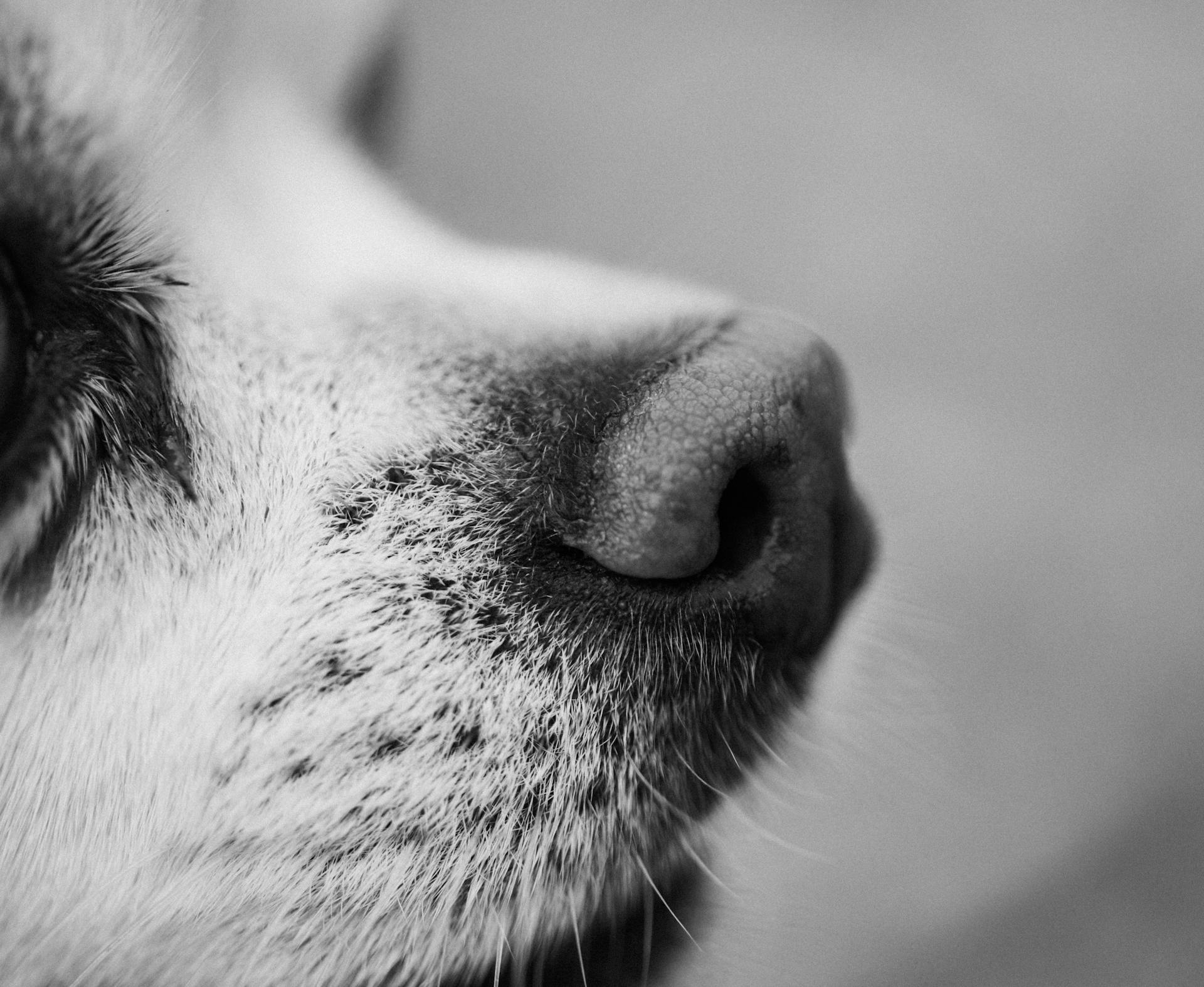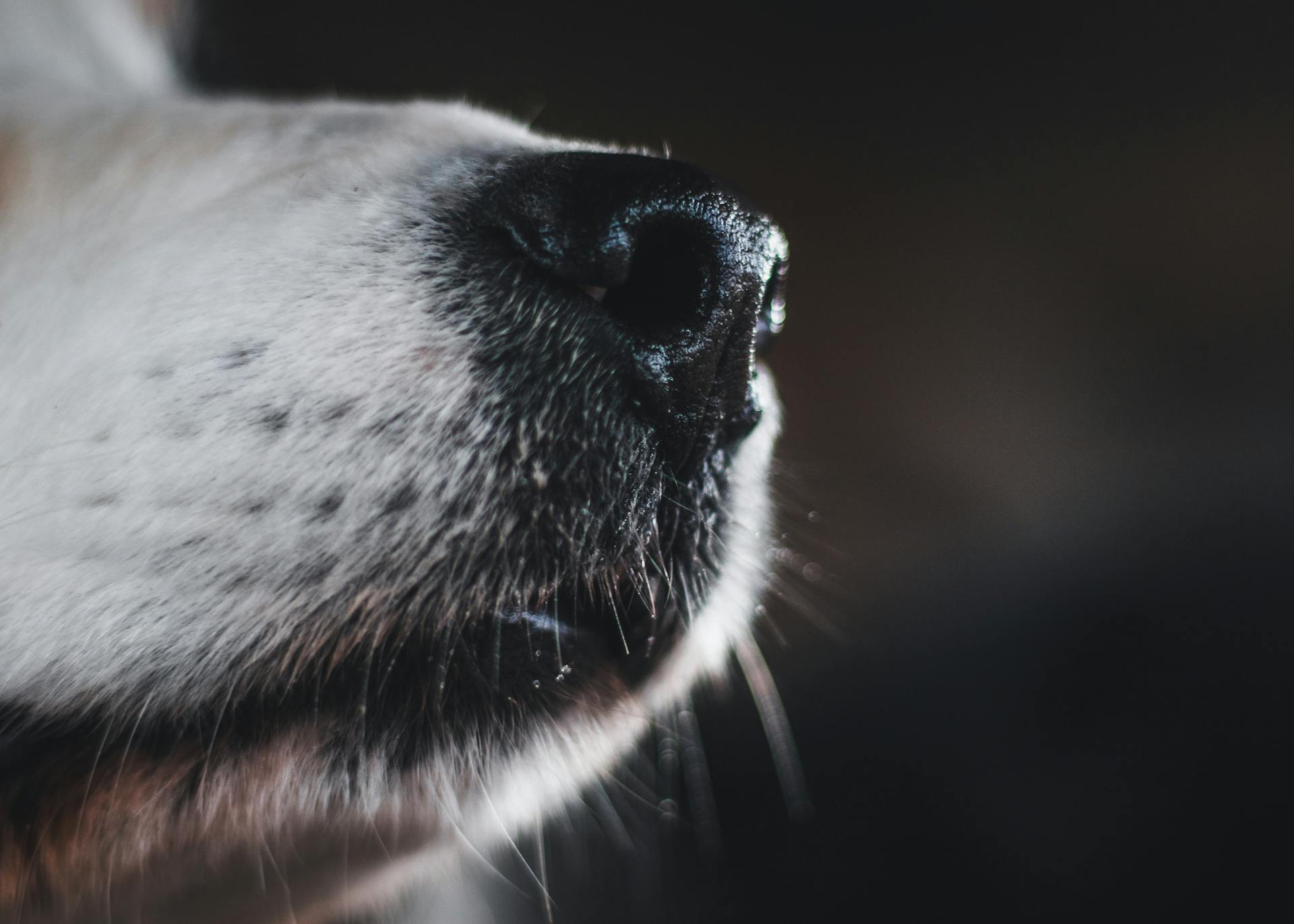
Kennel cough nasal discharge is a common and contagious respiratory infection in dogs. It's caused by the bacterium Bordetella bronchiseptica, which can be spread through direct contact with an infected dog's respiratory secretions.
Symptoms of kennel cough include a persistent cough, runny nose, and sneezing. The cough is often described as a harsh, hacking sound.
The nasal discharge associated with kennel cough is usually yellow or green in color, and can be accompanied by a bad odor. In severe cases, the discharge can be thick and sticky.
Kennel cough is highly contagious and can spread quickly in areas where dogs congregate, such as dog parks, kennels, and veterinary clinics.
You might like: Canine Nasal Cancer Symptoms
Causes of Kennel Cough
Kennel cough is a highly contagious respiratory disease that affects dogs worldwide. It's caused by a combination of viruses and bacteria, including Bordetella bronchiseptica, canine adenovirus, parainfluenza virus, and canine influenza virus.
Bordetella bronchiseptica is a gram-negative coccobacilli that's highly contagious and can be spread through the air, contaminated surfaces, or direct contact with an infected dog. It can cause mild to severe respiratory disease, including coughing, sneezing, and nasal discharge.
See what others are reading: Respiratory Allergies in Dogs
Canine adenovirus-2 is a nonenveloped double-stranded DNA virus that's a worldwide cause of infectious respiratory disease in dogs. It infects the respiratory epithelial cells, causing mild clinical signs such as sneezing, nasal discharge, and a dry cough.
Canine parainfluenza virus is an enveloped single-stranded negative-sense RNA virus that's a highly contagious cause of respiratory disease in dogs. It can be spread through respiratory droplets and causes mild to severe clinical signs, including a harsh cough, pyrexia, and nasal discharge.
Canine influenza virus is caused by two subtypes of influenza that have adapted to spread throughout the dog population. It can cause mild to severe clinical signs, including lethargy, cough, nasal and ocular discharge, and pneumonia.
Here's a breakdown of the common causes of kennel cough:
In summary, kennel cough is a multifactorial disease caused by a combination of viruses and bacteria. Understanding the causes of kennel cough is crucial in implementing effective prevention and control measures to protect dogs from this distressing condition.
Transmission and Spread
Kennel cough nasal discharge is a serious issue, and understanding how it spreads is crucial to preventing it. Close contact with other dogs is not necessary for transmission; the illness can spread up to 20 feet.
Overcrowding and poor ventilation in kennels can contribute to the spread of kennel cough. This is why dog owners need to be vigilant about their pets' surroundings to minimize the risk of infection.
Dogs can catch kennel cough through direct contact with contaminated surfaces, including water and food bowls, toys, and enclosures. This is why regular cleaning and disinfecting of these areas is essential.
The disease can spread rapidly, particularly in multiple-dog settings, and some of the associated organisms can survive in the environment for weeks. This makes controlling the spread of infection challenging.
If you suspect your dog has kennel cough, it's essential to keep them away from other dogs until they're fully recovered.
A fresh viewpoint: Essential Oils for Kennel Cough
Diagnosis and Treatment
Diagnosis of kennel cough nasal discharge typically involves a visit to the veterinarian, who will examine your dog for signs of illness and rule out other causes of cough. If your dog is mildly affected, a presumptive diagnosis of CIRDC can be made based on the veterinarian's examination.
Your veterinarian may ask about exposure to other dogs or multiple-dog settings, which can strengthen suspicions of kennel cough. If multiple dogs are affected, or if your dog seems to be getting worse despite supportive treatment, testing is recommended.
Diagnostic testing typically involves collecting swab samples from the throat, nose, and/or edges of the eyes and submitting them for lab testing to confirm infection and identify the specific bacteria or viruses involved. In some cases, blood tests may also be recommended.
Here are some key points to keep in mind:
- Dogs with mild CIRDC may not require diagnostic testing.
- Testing is recommended for dogs with severe illness or those that don't respond to supportive care.
- Diagnostic testing can help identify the underlying bacteria or virus causing kennel cough.
Treatment for kennel cough typically involves supportive care, such as rest, nutrition, and hydration, to help your dog recover from the illness. In some cases, antibiotics may be prescribed if there are signs of bacterial pneumonia or if your dog is severely ill.
Diagnosis and Treatment
Diagnosis of kennel cough, also known as canine infectious respiratory disease (CIRD), typically starts with a visit to the veterinarian. If you suspect your dog has kennel cough, it's a good idea to call your vet before taking your dog in to be seen and describe any signs you've noticed.
Your veterinarian will make a "presumptive" diagnosis of CIRDC by examining your dog for signs of illness, ruling out other causes of cough, and asking questions about exposure to other dogs or multiple-dog settings. If your dog is showing mild symptoms, your vet may not need to run any diagnostic tests.
Testing is recommended when multiple dogs are affected or if your dog seems to be getting worse despite supportive treatment. In those cases, your vet will collect swab samples from your dog's throat, nose, and/or eyes to confirm infection and identify the specific bacteria or viruses involved.
In most cases, treatment of kennel cough involves supportive care, which means providing your dog with the care they need to feel better without using medication. If your dog's symptoms have been present for less than a week and they're eating well and acting normally, no specific therapy is recommended.
Related reading: Signs of Advanced Diabetes in Dogs

Your vet may recommend expectorant medications, such as guaifenesin, but they haven't been shown to be beneficial in reducing clinical signs of CIRDC. On the other hand, cough suppressants can be used to provide relief for your dog and you, especially if the cough persists for weeks.
In severe cases, your vet may prescribe antimicrobials to treat bacterial pneumonia or secondary infections. Doxycycline is recommended for dogs with suspected Bordetella bronchiseptica or Mycoplasma cynos infection.
Additional supportive care, such as hydration and nutritional support, oxygen therapy, nebulization, and coupage, may also be recommended to help your dog recover.
Herpesvirus
Canine herpesvirus-1, or CHV-1, is a serious virus that affects dogs, causing reproductive failure in bitches and severe illness in neonates.
The virus is highly contagious and can be spread through respiratory secretions, making it a significant risk in kennel situations where many dogs are housed together.
CHV-1 infects the epithelial cells of the upper-respiratory mucosa, and the incubation period is 6 to 10 days.
Consider reading: Difference between Kennel Cough and Upper Respiratory Infection

Symptoms of CHV-1 infection can include rhinitis, tracheobronchitis, and ocular signs such as keratitis and conjunctivitis.
CHV-1 becomes latent in neurologic tissue, meaning it can remain dormant for long periods of time, but can reactivate under stress or immunosuppression, causing intermittent shedding in respiratory secretions throughout the life of the patient.
Diagnosis
Diagnosis of CIRDC typically starts with a visit to the veterinarian, who will examine your dog for signs of illness and rule out other causes of cough. If your dog is showing mild symptoms, a presumptive diagnosis of CIRDC may be made based on the veterinarian's examination and knowledge of other cases in the area.
Veterinarians may also recommend testing to confirm the diagnosis and identify the specific bacteria or viruses involved. This is usually the case when multiple dogs are affected or if your dog is not responding to supportive treatment.
Diagnostic testing for CIRDC typically involves collecting swab samples from the throat, nose, and/or edges of the eyes, which are then submitted for lab testing. In some cases, blood tests may also be recommended.
A diagnosis of kennel cough in dogs can be made based on the dog's symptoms, history, and response to therapy. Identifying the underlying bacteria or virus is not always necessary.
However, diagnostic testing is recommended in certain situations, including:
- Dogs where pneumonia is suspected
- Dogs that do not respond to supportive care
- Dogs with signs of systemic disease
- If an outbreak is occurring in multiple dogs
The clinical diagnosis of CIRDC is often based on a history of exposure and physical examination findings. However, determining the etiologic agent requires specific diagnostic tests, which can be challenging due to widespread subclinical infections.
Here are some key points to keep in mind:
- Multiple bacterial and viral pathogens can result in clinical signs of CIRDC.
- A clinical diagnosis of CIRDC can typically be made with a history and physical examination.
- Diagnostic testing should be pursued in dogs with severe or prolonged clinical signs or in disease outbreak situations.
By understanding the diagnosis process, you can take steps to protect your dog and prevent the spread of CIRDC.
Treatment
Treatment is a crucial step in helping your dog recover from kennel cough. For mild cases, supportive care such as rest, nutrition, and hydration is usually all that's needed.
Dogs can dry out from all the coughing, so keeping them in the bathroom while you shower is a good way to help them keep their airways moist. Adding a humidifier to the room they sleep in may also be beneficial.

A cough suppressant may be prescribed by your veterinarian to help reduce the frequency of the cough. This can provide relief for both you and your dog.
In some cases, kennel cough can lead to secondary bacterial infections, which may require antibiotics. However, antibiotics are not always necessary and should only be used if a bacterial infection is suspected.
If your dog is experiencing a severe case of kennel cough, hospitalization, intravenous fluids, and antibiotics may be necessary. Oxygen therapy may also be required in extreme cases.
To help your dog recover, it's essential to avoid irritants such as household cleaners, cigarette smoke, and dust. These can cause more irritation and prolong your dog's recovery.
To prevent further irritation to the trachea, it's recommended to use harnesses instead of collars and leashes. This can help reduce coughing and make your dog more comfortable.
You might enjoy: Antibiotics for Kennel Cough in Puppies
Prevention of Infectious Disease
Keeping your dog's vaccines current is one of the best ways to protect them against infectious diseases like kennel cough. Vaccines not only reduce the chance of your dog becoming ill but also make them less likely to develop severe disease or spread the infection to other dogs.
Standard canine vaccines are highly effective against some CIRDC-associated viruses and are recommended for all dogs. For optimal protection against common respiratory infections, an annual intranasal vaccine against Bordetella, canine adenovirus type 2, and canine parainfluenza is recommended for dogs of certain at-risk groups.
Dogs can be contagious and still look perfectly healthy, so it's essential to keep them away from toys and food and water bowls used by dogs outside your household.
To further protect your dog, stay informed by asking your veterinarian or checking news or internet resources about places or geographic regions where CIRDC or more specific respiratory infections like canine influenza have been reported.
Here are some other tips to help prevent the spread of infectious diseases:
- Delay or avoid travel with your dog to places where outbreaks are occurring.
- Keep your dog's bedding, toys, and food and water bowls clean and disinfected regularly.
- Ensure your dog receives a balanced diet, regular exercise, and proper veterinary care to enhance their overall health and immune response.
By following these prevention methods, you can significantly reduce the risk of your dog contracting infectious diseases like kennel cough.
Frequently Asked Questions
What color is phlegm with kennel cough?
Phlegm associated with kennel cough is typically frothy and white in color
How do you know if kennel cough turns into pneumonia?
Look out for labored breathing, a moist cough, high fever, and nasal discharge, which can indicate pneumonia has developed from kennel cough
Sources
- https://www.avma.org/resources-tools/pet-owners/petcare/canine-infectious-respiratory-disease-complex-kennel-cough
- https://www.ncbi.nlm.nih.gov/pmc/articles/PMC7132485/
- https://www.cityvet.com/understanding-kennel-cough-in-dogs-signs-prevention-and-treatment/
- https://www.petmd.com/dog/conditions/respiratory/kennel-cough-dogs-symptoms-and-treatments
- https://snoutsnstouts.com/dog-safety/how-do-dogs-get-kennel-cough/
Featured Images: pexels.com


